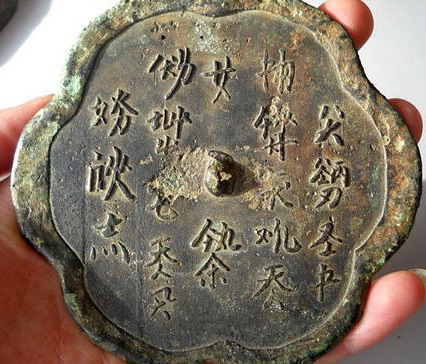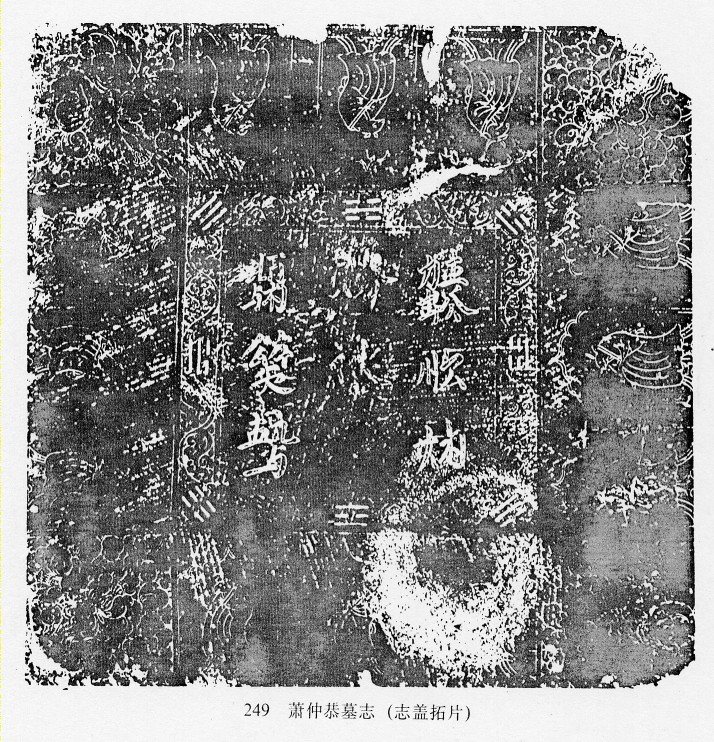BabelStone Blog
Monday, 11 July 2011
A Mirror on the Khitan Language
Several bronze mirrors with Khitan inscriptions are known, including this well known example with a 28 character poetic inscription in the Small Khitan script :
Bronze mirror with Small Khitan inscription at the National Museum, Seoul, Korea
[CC-BY-SA-2.0 by John S Y Lee]
However, such mirrors are exceedingly rare, and so when a correspondent recently sent me a picture of a bronze mirror with an unreadable inscription that had been unearthed in Inner Mongolia I was naturally delighted to find that the unknown writing on the mirror was actually the Small Khitan script :

Bronze mirror from Ulanqab, Inner Mongolia
[picture courtesy of Andrey Shakhman]
𘰲 𘰴𘬛𘲢 𘲝 𘲐
𘲐𘲦 𘰷𘱄𘮽 𘬈 𘲜𘰣 𘬪
𘭧 𘰷𘲼𘰹
𘰕𘯛 𘭞𘱄𘮠 𘰯 𘬪 𘲺
𘭧𘱮 𘱚𘱆 𘭙
The mirror was reportedly found somewhere in the viscinity of Ulanqab in central Inner Mongolia. This would have been on or just beyond the border of the Jin regime (during which time the mirror was cast), and somewhat distant from the Khitan homeland of Liaoning and eastern Inner Mongolia, where large numbers of Khitan memorial tablets dating to the Liao and Jin dynasties have been found (see map). However, we would expect to see a wider distribution of portable objects such as mirrors compared to the distribution of memorial tablets, so the find location is plausible.
The mirror is in relatively good condition, with a clear and legible inscription, and based on both the physical form of the mirror and the inscription on it, it appears to be genuine (although not having held it in the hand I cannot be 100% certain). Curiously enough, for an extinct and poorly understood language written in a largely undeciphered script, the inscription on the mirror is completely understandable, and I translate it thus :
| On the 19th day of the 9th month (the month of the wood dog) in the 2nd year of the Tiande era (the year of the metal horse) [1150], the Prince of the State of Yue. | ||
| 天德二年歲次庚午九月甲戌十九日越國王 |
The reason why this particular inscription is so easy to translate is that it uses a limited range of calendrical vocabulary that is attested on many monumental inscriptions. For reference, I have provided several tables of calendrical vocabulary for both Khitan large and small script at the bottom of this post. These are largely, but not entirely, based on Professor Daniel Kane's The Kitan Language and Script (Brill, 2009). The images of small Khitan logograms and phonograms on this page are from an experimental small Khitan font that I created especially for this blog post. I intend to work on this font further after the summer, and will make it available for free download at a future date. In the meantime, I have made Professor Kane's list of 380 small Khitan glyphs available here.
Analysis of the Inscription on the Mirror
The Small Khitan script is a mixed writing system comprising single-character logograms representing the meaning of certain high frequency words such as numbers, together with multi-character phonogram clusters (which I will call "polygrams", following Vladimir Sergeevich Starikov) that represent the pronunciation of a word (a few characters act as both logograms and phonograms). A polygram comprises between one and eight phonograms arranged into a rectangular block, with the individual phonograms making up the polygram ordered left-to-right and top-to-bottom. The readings for phonograms given here follow Kane 2009, and the reconstructed pronunciations for Chinese glosses of Khitan words have been kindly provided by Marc Miyake.
| Khitan | Reading | Interpretation |
|---|---|---|
𘰲 |
Logogram meaning "heaven", here used as part of a reign era name. Khitan reign era names almost always start with either this character or the logogram for "great". | |
𘰴𘬛𘲢 |
d.iu.rẻn | Polygram representing the Khitan word meaning "virtue" (Chinese dé 德). This and the preceding word "heaven" form the Khitan name for the Jin dynasty Tiande (天德) "Heavenly Virtue" reign era (1149–1153). |
𘲝 |
Logogram meaning "two". | |
𘲐 |
Logogram meaning "year". Up to this point the inscription means "2nd year of the Tiande era", which corresponds to the year 1150. | |
𘲐𘲦 |
ai.en | Polygrams representing the Khitan word for "cyclical year" (Chinese suìcì 歲次), which go with the following two words to give the cyclical year corresponding to the reign year Tiande 2, i.e. the year of the metal horse. |
𘰷𘱄𘮽 |
se.l.bo | |
𘬈 |
Logogram meaning "white", here corresponding to the element metal and the heavenly stem 庚 (gēng) in the Chinese calendrical system. | |
𘲜𘰣 |
mo.ri | Polygram representing the Khitan word "horse" (cf. Mongolian ᠮᠣᠷᠢᠨ mori(n)), corresponding to the earthly branch 午 (wǔ) in the Chinese calendrical system. |
𘬪 |
Logogram meaning "nine". | |
𘭧 |
*sair | Logogram meaning "month". The Chinese gloss for the Khitan word for "month" given in the History of the Liao Dynasty is 賽咿兒 (sàiyī'ér) *sair, cognate to Mongolian ᠰᠠᠷᠠᠨ sara(n) meaning "moon" or "month". |
𘰷𘲼𘰹 |
s.au.qu | Polygram representing the Khitan word that corresponds to the element wood and the heavenly stem 甲 (jiǎ) in the Chinese calendrical system, probably meaning "blue". This word is also written as 𘰷𘱹𘮄 s.iau.qú or 𘰷𘱹𘰹 s.iau.qu, with different medial and/or final phonograms. The medial phonogram as written on the mirror looks like 𘯽 (mú) but should in fact be 𘲼 (au). This mistake throws some doubt on the authenticity of the inscription. |
𘰕𘯛 |
ńi.qo | Polygram representing the Khitan word "dog" (cf. Mongolian ᠨᠣᠬᠠᠢ noqai). |
𘭞𘱄𘮠 |
ho.l.bun | Polygram of uncertain meaning that always occurs after lunar cyclical dates, presumably indicating that the preceding two words are the cyclical terms corresponding to the calendar month. |
𘰯 |
Logogram meaning "ten". | |
𘬪 |
Logogram meaning "nine". | |
𘲺 |
Logogram meaning "day". The Chinese gloss for the Khitan word for "day" given in the History of the Liao Dynasty is 捏咿唲 (niēyī'ér) *ñair, cognate to Mongolian ᠨᠠᠷᠠᠨ nara(n) meaning "sun". | |
𘭧𘱮 |
y.e | Polygram representing the Khitan transcription of the Chinese place name Yue 越. The first phonogram is the same as the logogram for "month" (see above), but here may be equivalent to the dotted form of the same graph that is elsewhere used as a phonogram for y. |
𘱚𘱆 |
g.ui | Polygram representing the Khitan transcription of the Chinese word 國 "country". In modern Mandarin 國 is pronounced guó, but in Old Mandarin it was homophonous with characters that are pronounced gui in modern Mandarin (cf. the Phags-pa spelling of ꡂꡟꡠ gue for 國). The native Khitan word for country is 𘱚𘮒𘲦 g.úr.en, cognate with Jurchen gurun and Manchu ᡤᡠᡵᡠᠨ gurun. |
𘭙 |
oŋ | Polygram representing the Khitan transcription of the Chinese word wáng 王 "prince". These last three words together transcribe the Chinese title 越國王 "Prince of the State of Yue", and is attested on the Memorial for Xiao Zhonggong (see below). |
Please see this post (2011-07-10) and this post (2011-07-11) on Amaravati: Abode of Amritas for Marc Miyake's notes on the Khitan characters on the mirror inscription.
Who was the Prince of Yue?
The Prince of Yue refers to Xiao Zhonggong 蕭仲恭 (1090–1150) [《金史》卷八十二], a Liao dynasty general who was captured with the last Liao emperor in 1125, and who subsequently pledged allegiance to the Jin dynasty. He served the Jin dynasty faithfully for twenty-five years, serving in various high positions and receiving numerous titles. In the first month of Tiande 2 [1150] he was made Prince of the State of Yue, but just a few months later, on the 2nd day of the 5th month, the day before his 60th birthday, he died of natural causes. Xiao Zhonggong's tomb in Xinglong county, Hebei was robbed by local peasants in 1942, and his memorial tablet was discarded on the open ground nearby. In 1954 the memorial tablet was recovered by the Jehol Provincial Museum, and found to comprise a long inscription in the Small Khitan script (at 50 lines in length, it is one of the longest known Khitan texts).
Lid for the Memorial Tablet for Xiao Zhonggong

Source: Zhōngguó Mínzú Gǔ Wénzì Túlù 中國民族古文字圖錄 (Beijing: Zhongguo Shehui Kexue Chubanshe, 1990) ill. 249a
The middle three words, now defaced, apparently read "Prince of the State of Yue" (越國王) in Khitan, although I cannot make them out. The bottom two characters on the 3rd (leftmost) line are the Khitan for "memorial tablet" (墓誌).
The memorial tablet for Xiao Zhonggong is dated the 19th day of the 9th month of Tiande 2, the exact same date as the inscription on the mirror, and so it can reasonably be supposed that the mirror was cast in memory of Xiao Zhonggong at the time of his entombment.
In conclusion, we have an inscription that on the one hand is completely understandable, but on the other hand tells us almost nothing about the Khitan language. We can work out the rough pronunciations for a large number of Chinese words transcribed using Khitan polygrams, and work out the meaning (but not pronunciation) of logograms representing a small number of Khitan words, with the result that we can read and understand simple sinified Khitan text, but still we don't have much of a clue when it comes to pure Khitan text. Sadly, this mirror merely reflects our fundamental lack of understanding about the Khitan language.
To tell you the truth, the Khitan script is becoming more and more incomprehensible. Things which we were not able to understand before we are even less able to understand now. — Nishida Tatsuo 西田龍雄, 1991
Last modified: 2020-03-26
Index of BabelStone Blog Posts
